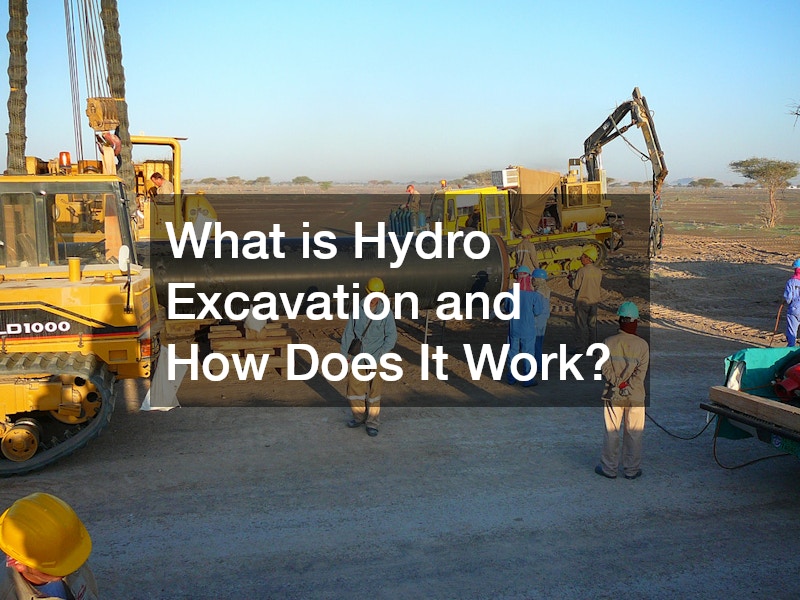In modern civil construction, accuracy and efficiency are critical to the success of every project. Whether it’s digging around sensitive utility lines or preparing foundations for new infrastructure, contractors require excavation methods that are safe, precise and environmentally responsible. Hydro excavation, a non-destructive digging technique that has gained prominence across Australia, offers a superior alternative to traditional mechanical excavation methods. This innovative process is transforming the way industries approach subsurface work, delivering a host of benefits that improve safety, reduce risk and increase productivity.
Understanding the Basics of Hydro Excavation
Hydro excavation is a process that uses high-pressure water to break up soil, which is then removed by a powerful vacuum system. This technique enables crews to dig with pinpoint accuracy while avoiding damage to underground assets such as gas lines, electrical cables, telecommunications conduits and water pipes. Unlike mechanical digging, which can often result in accidental strikes or over-excavation, hydro excavation provides a level of control that is critical when working in densely populated urban environments or near vital infrastructure.
This method relies on a combination of specialised equipment mounted on trucks or trailers. The high-pressure water is sprayed through a handheld wand or boom-mounted nozzle, loosening the soil. Simultaneously, a vacuum hose extracts the resulting slurry of water and soil into a debris tank for later disposal. Because the entire process is self-contained and minimally invasive, it is ideal for projects where preserving surrounding structures and maintaining a clean job site are priorities.
How the Process Works
The hydro excavation process begins with careful site planning and risk assessment. Operators assess the location of underground utilities, local soil conditions and access points to ensure the safest and most efficient approach. Once the target area is identified, the operator positions the hydro excavation truck nearby and prepares the equipment.
Operators have precise control over the water pressure and vacuum strength, which allows them to adjust their approach depending on the soil type and sensitivity of nearby utilities. For instance, softer soils require less pressure, while more compacted ground may need higher levels of force. Throughout the process, spoil is continuously removed, leaving a clean, clearly defined excavation area that can be used for inspections, repairs or installations.
Applications Across Industries
Hydro excavation is used across a wide range of industries, including civil construction, plumbing, telecommunications, energy and municipal services. One of its most common applications is potholing or daylighting—digging small, precise holes to expose underground utilities for inspection or mapping. This is especially useful for engineers and surveyors who need to verify the location of existing assets before commencing work.
In addition, this method is widely used for trenching, pole or sign installation and debris removal. Because hydro excavation does not rely on metal tools or machinery to penetrate the soil, it significantly reduces the risk of damaging delicate infrastructure. It is also increasingly used in remote or ecologically sensitive areas, where preserving vegetation and minimising surface disruption are essential.
For industries operating in colder climates, hydro excavation trucks can be equipped with heated water systems, enabling operators to dig even through frozen ground. This adaptability makes it a reliable solution for year-round operations in both urban and rural environments.
Advantages of Hydro Excavation
One of the most notable advantages of hydro excavation is its ability to protect underground infrastructure. Utility strikes can cause major delays, repair costs and in some cases, serious injury or environmental harm. By using water instead of mechanical force, this method significantly lowers the risk of accidental damage, making it a preferred choice for work near critical infrastructure.
Another key benefit is its precision. Traditional excavation methods often require large trenches or wide clearances to ensure the safe exposure of underground systems. Hydro excavation, by contrast, enables operators to remove only the necessary volume of soil, leading to smaller, cleaner work areas and faster restoration times. This precision also results in less backfilling and reduced materials costs.
Environmental impact is another important consideration. Since the removed soil is stored in a contained tank, there is minimal disruption to the surrounding ecosystem. This makes it a preferred method for excavation near waterways, tree roots and heritage sites.
The Future of Excavation Technology
As the demand for safer and more sustainable construction practices continues to grow, hydro excavation is poised to play an increasingly prominent role in infrastructure development across Australia. With advancements in equipment technology and increased awareness of the benefits it offers, more contractors are integrating this method into their standard operating procedures.
Governments and utility providers are also recognising its value, particularly in urban renewal projects where existing infrastructure must be preserved. Whether it’s identifying underground assets, repairing damaged pipes or laying the groundwork for new developments, hydro excavation provides a modern solution that balances efficiency with responsibility.
Why Hydro Excavation Is the Smarter, Safer Way to Dig
Hydro excavation represents a significant leap forward in excavation technology. By using water and vacuum power to dig safely and precisely, it minimises risk, protects essential infrastructure and supports environmentally conscious construction. As industries evolve to meet the challenges of modern development, this innovative method will remain a cornerstone of safe and efficient subsurface work. With its wide range of applications and growing reputation, hydro excavation is not just a trend—it’s the future of digging in Australia.
.

